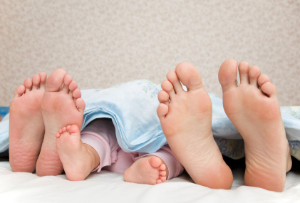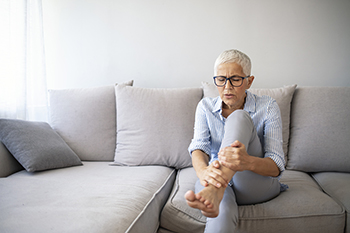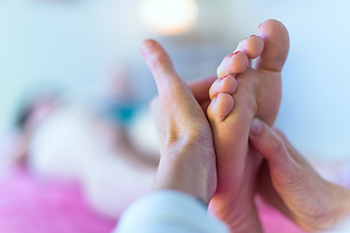August 2022
Juvenile Plantar Dermatosis

Juvenile plantar dermatosis is a common and chronic dry skin condition of the feet that usually affects pre-adolescent children between the ages of three and 14 years. It is also known as atopic winter feet and forefoot dermatitis. This condition affects boys slightly more often than girls. It is rarely seen in adults but can persist into adulthood. Juvenile plantar dermatosis can be caused by repetitive frictional movements, the occlusive effect of wearing covered footwear (particularly synthetic shoes), excessive sweating, genetic sensitivities, or warm or cool climate changes. This problem is usually visible on the weight-bearing areas of the soles, ball of the big toes, and forefoot of the foot with itchy, sore, shiny, red skin that has a glazed appearance and a loss of the epidermal ridge pattern. Typically, both feet are affected. The most common complication of juvenile plantar dermatosis is painful cracks and fissures, which may become infected. This affliction is sometimes confused with other skin conditions, such as atopic eczema, plantar psoriasis, or tinea pedis. Wearing well-fitting leather shoes, two or more pairs of cotton and wool socks, and changing socks regularly will help reduce friction. Moisturizing the feet will help prevent dry skin. Resting the feet to allow any fissures to heal will help as well. If your child is experiencing problems with the skin of their feet, consult with a podiatrist who can diagnose any conditions and provide options for treatment.
Making sure that your children maintain good foot health is very important as they grow. If you have any questions, contact Steven Spivak, DPM of Mount Holly Family Footcare. Our doctor can provide the care you need to keep you pain-free and on your feet.
Keeping Children's Feet Healthy
Having healthy feet during childhood can help prevent medical problems later in life, namely in the back and legs. As children grow, their feet require different types of care. Here are some things to consider...
Although babies do not walk yet, it is still very important to take care of their feet.
Avoid putting tight shoes or socks on his or her feet.
Allow the baby to stretch and kick his or her feet to feel comfortable.
As a toddler, kids are now on the move and begin to develop differently. At this age, toddlers are getting a feel for walking, so don’t be alarmed if your toddler is unsteady or ‘walks funny’.
As your child gets older, it is important to teach them how to take care of their feet.
Show them proper hygiene to prevent infections such as fungus.
Be watchful for any pain or injury.
Have all injuries checked by a doctor as soon as possible.
Comfortable, protective shoes should always be worn, especially at play.
If you have any questions please feel free to contact our office located in Lumberton, NJ . We offer the newest diagnostic and treatment technologies for all your foot and ankle needs.
Methods That May Help to Prevent Running Injuries

Preventing running injuries is a common concern for people who enjoy running, even though they may feel that there is not enough time to effectively warm up and cool down. This can be detrimental to incurring injuries. It takes minimal effort to practice good running habits. Preventing running injuries can consist of gradually increasing speed and distance and this is important so that the legs and feet can become acclimated to running. Some people prefer to use props to stay strong and healthy, including a foam roller that can help to increase range of motion and flexibility. Additionally, when a medicine ball is used, it may increase overall body strength. People who enjoy running often set goals as part of their running strategy, and it is beneficial to the body to consistently stay on point. If you would like more information about how running injuries can affect the feet and injury prevention methods, please consult with a podiatrist who can address any concerns you may have.
Exercising your feet regularly with the proper foot wear is a great way to prevent injuries. If you have any concerns about your feet, contact Steven Spivak, DPM of Mount Holly Family Footcare. Our doctor will treat your foot and ankle needs.
How to Prevent Running Injuries
Many common running injuries are caused by overuse and overtraining. When the back of the kneecap starts wearing out and starts causing pain in your knee, this is commonly referred to as runner’s knee. Runner’s knee is a decrease in strength in your quadriceps and can occur if you’re not wearing properly fitted or supporting shoes. To prevent runner’s knee, focusing on hip strengthening is a good idea, as well as strengthening your quads to keep the kneecaps aligned.
What Are Some Causes of Running Injuries?
- One cause of a common running injury is called iliotibial band syndrome.
- Plantar fasciitis is also another common injury.
- Stress fractures can occur from overtraining, lack of calcium, or even your running style.
Best Ways to Prevent Running Injuries
- Wear footwear that fits properly and suits your running needs.
- Running shoes are the only protective gear that runners have to safeguard them from injury.
- Make a training schedule. Adding strengthening exercises as well as regular stretching can help keep you strong and limber and can lessen the possibility of injuries.
- Stretching keeps muscles limber; this will help you gain better flexibility.
If you have any questions please feel free to contact our office located in Lumberton, NJ . We offer the newest diagnostic and treatment technologies for all your foot and ankle needs.
Plantar Fasciitis Is a Common Type of Heel Pain

Because heel pain can be caused by several conditions, it is important to have it diagnosed correctly and treated properly. The most common form of heel pain is plantar fasciitis. This is an inflammatory condition of the plantar fascia, which is the long rubber band-like connective tissue that connects the front of the heel bone with the toes. The plantar fascia is on the bottom of the foot. It undergoes a great deal of stress and pressure while doing its duty of helping to form the arch, aiding in the propulsive phase of the walking cycle, and acting like a shock absorber of sorts. Excessive wear and tear and stretching of the plantar fasciitis can irritate it, inflame it, and even create micro-tears where it inserts at the heel bone. This is known as plantar fasciitis, a very painful form of heel pain. Plantar fasciitis can be brought on by certain sporting activities like running, being obese, standing for prolonged periods, and more. If you have heel pain that is at its worst in the morning when you take your first steps of the day, or after periods of rest, you may have plantar fasciitis. Consult with a podiatrist to have your heel pain diagnosed and treated.
Plantar fasciitis can be very painful and inconvenient. If you are experiencing heel pain or symptoms of plantar fasciitis, contact Steven Spivak, DPM from Mount Holly Family Footcare. Our doctor can provide the care you need to keep you pain-free and on your feet.
What Is Plantar Fasciitis?
Plantar fasciitis is the inflammation of the thick band of tissue that runs along the bottom of your foot, known as the plantar fascia, and causes mild to severe heel pain.
What Causes Plantar Fasciitis?
- Excessive running
- Non-supportive shoes
- Overpronation
- Repeated stretching and tearing of the plantar fascia
How Can It Be Treated?
- Conservative measures – anti-inflammatories, ice packs, stretching exercises, physical therapy, orthotic devices
- Shockwave therapy – sound waves are sent to the affected area to facilitate healing and are usually used for chronic cases of plantar fasciitis
- Surgery – usually only used as a last resort when all else fails. The plantar fascia can be surgically detached from the heel
While very treatable, plantar fasciitis is definitely not something that should be ignored. Especially in severe cases, speaking to your doctor right away is highly recommended to avoid complications and severe heel pain. Your podiatrist can work with you to provide the appropriate treatment options tailored to your condition.
If you have any questions please feel free to contact our office located in Lumberton, NJ . We offer the newest diagnostic and treatment technologies for all your foot and ankle needs.
Arthritis May Cause Toe Pain

Pain, swelling, and stiffness often accompany arthritis in the feet. Many people have their toes affected by arthritis and it can be difficult to walk. Additionally, there may be a bump that forms as a result of the joints rubbing together and the toes may curl. The most common form of arthritis is known as osteoarthritis and it affects the cartilage between the joints generally causing pain and discomfort. The condition that is known as gout can cause pain in the big toe and comes from having excess uric acid in the bloodstream. This can cause crystals to lodge between the joints in the big toe and can cause debilitating pain. An autoimmune disease can cause psoriatic arthritis and typically affects the toes. Another form of toe pain can come from having an infection within the joint and this is referred to as infectious arthritis. Mild relief may be found when the shoes that are worn fit properly and it is advised to refrain from wearing high heels. If you have pain in your toes, please consult with a podiatrist who can effectively diagnose arthritis in the feet as well as offer correct treatment advice.
Arthritis can be a difficult condition to live with. If you are seeking treatment, contact Steven Spivak, DPM from Mount Holly Family Footcare. Our doctor can provide the care you need to keep you pain-free and on your feet.
Arthritic Foot Care
Arthritis is a term that is commonly used to describe joint pain. The condition itself can occur to anyone of any age, race, or gender, and there are over 100 types of it. Nevertheless, arthritis is more commonly found in women compared to men, and it is also more prevalent in those who are overweight. The causes of arthritis vary depending on which type of arthritis you have. Osteoarthritis for example, is often caused by injury, while rheumatoid arthritis is caused by a misdirected immune system.
Symptoms
- Swelling
- Pain
- Stiffness
- Decreased Range of Motion
Arthritic symptoms range in severity, and they may come and go. Some symptoms stay the same for several years but could potentially get worse with time. Severe cases of arthritis can prevent its sufferers from performing daily activities and make walking difficult.
Risk Factors
- Occupation – Occupations requiring repetitive knee movements have been linked to osteoarthritis
- Obesity – Excess weight can contribute to osteoarthritis development
- Infection – Microbial agents can infect the joints and trigger arthritis
- Joint Injuries – Damage to joints may lead to osteoarthritis
- Age – Risk increases with age
- Gender –Most types are more common in women
- Genetics – Arthritis can be hereditary
If you suspect your arthritis is affecting your feet, it is crucial that you see a podiatrist immediately. Your doctor will be able to address your specific case and help you decide which treatment method is best for you.
If you have any questions, please feel free to contact our office located in Lumberton, NJ . We offer the newest diagnostic and treatment technologies for all your foot care needs.
Foot Massage Therapy

Foot massage therapy, a type of massage that focuses on the feet and lower legs, is often used to relieve stress, tension, fatigue, and pain. It also can be used to improve blood circulation to help prevent injuries and alleviate symptoms of chronic conditions like arthritis. This form of massage utilizes gentle pressure to the feet and legs. Swedish or trigger point massage techniques are typically employed. Risks of foot massage therapy include infection from the spread of bacteria and injury, such as cuts and bruises from over-massage. If you have pre-existing medical conditions (like heart disease or stroke history), it is important to consult with a podiatrist before getting such therapy. A podiatrist can also provide additional information about foot massage therapy and provide additional suggestions to treat foot and ankle discomfort.
Foot therapy is often necessary for those recovering from either foot deformities or foot injuries. If you have concerns regarding therapy, consult with Steven Spivak, DPM from Mount Holly Family Footcare. Our doctor can provide the care you need to keep you pain-free and on your feet.
Most Common Injuries
People who are active or athletes are prone to a variety of injuries. Therefore, it is often important to take part in physical therapy in order to quickly get back on the right track.
What to Do When Injured
Physical Therapy – This specialized treatment will focus on the affected area, speeding up recovery and the overall healing process. It is a proven method that has helped millions of people return from any injury.
During physical therapy you will undergo regimented training to get back into full form. Training is often very difficult, especially at first when the foot feels weak. Physical therapy often involves:
Basic stretching and twisting exercises – getting the feet’s mobility and flexibility up.
Massaging – the therapist will massage the injured area in order to activate the muscles and relax them.
Strengthening Exercises – this allows the muscles in the affected area to regain their full strength, a vital step towards full recovery.
If you have any questions please feel free to contact our office located in Lumberton, NJ . We offer the newest diagnostic tools and technology to treat your foot and ankle needs.





